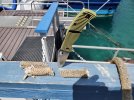Sal, would it be possible to give a general idea of the time frame when we might see the larger version of the Caribbean, like should we budget for this year or so? It's an exciting idea for several reasons. There's such a shortage of efficient large folders with good build quality, wear, toughness, & corrosion resistance. I appreciate all the homework you put into this one.
Here are some things I hope to see:
Here are some things I hope to see:
- No finger choil please- To me the full length cutting edge is the Caribbean's selling point. I know some people like having the option to choke up, but choils are disappointingly commonplace & inefficient. They're unnecessary for fine control if the blade heel is situated near the index finger placement. Choils really throw off the important cutting edge to handle & weight ratios and force users to grip too close or too far from the material. They make you slow down so they don't catch material before you can cut it. Even more importantly, handle ergonomics generally can't be optimized for both a normal and choked-up grip. The contact points are thrown off, especially palm swell & finger position, reducing comfort and application of force. Most who doubt this probably haven't held ever a knife that is truly contoured to fit the hand, and are simply observing that the hand can manage to grip objects of various shapes.
- Good value - the Caribbean may be the closest thing to it Spyderco offers, and Chinese quality is catching up.
- LC200N- as hard as you can reasonably HT it, and please report the HRC range
- A minimal closed profile
- The tip shouldn't fall more than a couple mm short of the handle butt
- Sink the blade as deeply into the handle as possible by changing features that force its protrusion
- A much smaller Spydie hole or better a thumb stud placed near the handle will accomplish this and reduce stress risers for a more robust blade
- When you have to include a lanyard hole on a model, put it out of the way, e.g. in the backspacer
- A strong retractable lanyard accessory secured to the user with a mini carabiner would be perfect for applications on ropes or boats. The knife won't get entangled or dropped.
- The tip shouldn't fall more than a couple mm short of the handle butt
- Keep it as light as possible in G10.
- Handle should be sculpted to fit normal hands too, not just huge ones, as you elongate the knife. Please don't make it taller.
- Smoother action- swing open & shut with compression lock, but keep tight tolerances & PB washers.
- 2-2.25" Half serrated option- kept shallow & near the original edge to reduce thickness and allow a smooth transition from serration to plain edge while cutting
- Even better, an option to buy an extra fully serrated blade at minimal cost for savvy users to switch out at will with their plain edge.
- Grind serrations on back side, not show side. They'll cut noticeably better as right hand tends to rotate slightly outward while slicing. Function over marketing aesthetics please!
- Fully hardened and rustproof screws & other good hardware, a past concern
- Keep the sheepsfoot option to avoid puncture and accidents during water or rescue work. The distal spine could be rounded off a little more.
- Make sure the compression lock cutout doesn't interfere with ergonomics & force application in any grip
- 0.010" behind the edge (or just slightly more with serrations), .13-.14" stock.
- Chamfering/contouring, including any Spydie hole. Also can break up the stripped pattern a bit, which puts some customers off but clearly has visibility purposes. Keep the vivid two-tones, though some may prefer the option of other colors.
- Make sure the pocket clip lands completely on and around smoothed or very lightly textured G10.
- Please offer more models with similar design principles (max cutting egde & min closed profile), like a large drop point with good belly in Z-wear at 62+ HRC.

